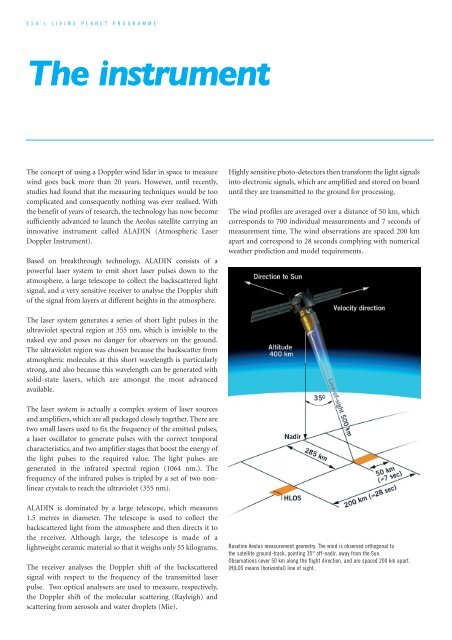ADM-Aeolus brochure (pdf) - ESA
ADM-Aeolus brochure (pdf) - ESA
ADM-Aeolus brochure (pdf) - ESA
Create successful ePaper yourself
Turn your PDF publications into a flip-book with our unique Google optimized e-Paper software.
<strong>ESA</strong>’s LIVING PLANET PROGRAMME<br />
The instrument<br />
The concept of using a Doppler wind lidar in space to measure<br />
wind goes back more than 20 years. However, until recently,<br />
studies had found that the measuring techniques would be too<br />
complicated and consequently nothing was ever realised. With<br />
the benefit of years of research, the technology has now become<br />
sufficiently advanced to launch the <strong>Aeolus</strong> satellite carrying an<br />
innovative instrument called ALADIN (Atmospheric Laser<br />
Doppler Instrument).<br />
Based on breakthrough technology, ALADIN consists of a<br />
powerful laser system to emit short laser pulses down to the<br />
atmosphere, a large telescope to collect the backscattered light<br />
signal, and a very sensitive receiver to analyse the Doppler shift<br />
of the signal from layers at different heights in the atmosphere.<br />
The laser system generates a series of short light pulses in the<br />
ultraviolet spectral region at 355 nm, which is invisible to the<br />
naked eye and poses no danger for observers on the ground.<br />
The ultraviolet region was chosen because the backscatter from<br />
atmospheric molecules at this short wavelength is particularly<br />
strong, and also because this wavelength can be generated with<br />
solid-state lasers, which are amongst the most advanced<br />
available.<br />
The laser system is actually a complex system of laser sources<br />
and amplifiers, which are all packaged closely together. There are<br />
two small lasers used to fix the frequency of the emitted pulses,<br />
a laser oscillator to generate pulses with the correct temporal<br />
characteristics, and two amplifier stages that boost the energy of<br />
the light pulses to the required value. The light pulses are<br />
generated in the infrared spectral region (1064 nm.). The<br />
frequency of the infrared pulses is tripled by a set of two nonlinear<br />
crystals to reach the ultraviolet (355 nm).<br />
ALADIN is dominated by a large telescope, which measures<br />
1.5 metres in diameter. The telescope is used to collect the<br />
backscattered light from the atmosphere and then directs it to<br />
the receiver. Although large, the telescope is made of a<br />
lightweight ceramic material so that it weighs only 55 kilograms.<br />
The receiver analyses the Doppler shift of the backscattered<br />
signal with respect to the frequency of the transmitted laser<br />
pulse. Two optical analysers are used to measure, respectively,<br />
the Doppler shift of the molecular scattering (Rayleigh) and<br />
scattering from aerosols and water droplets (Mie).<br />
Highly sensitive photo-detectors then transform the light signals<br />
into electronic signals, which are amplified and stored on board<br />
until they are transmitted to the ground for processing.<br />
The wind profiles are averaged over a distance of 50 km, which<br />
corresponds to 700 individual measurements and 7 seconds of<br />
measurement time. The wind observations are spaced 200 km<br />
apart and correspond to 28 seconds complying with numerical<br />
weather prediction and model requirements.<br />
Baseline <strong>Aeolus</strong> measurement geometry. The wind is observed orthogonal to<br />
the satellite ground-track, pointing 35° off-nadir, away from the Sun.<br />
Observations cover 50 km along the flight direction, and are spaced 200 km apart.<br />
(H)LOS means (horizontal) line of sight.

















